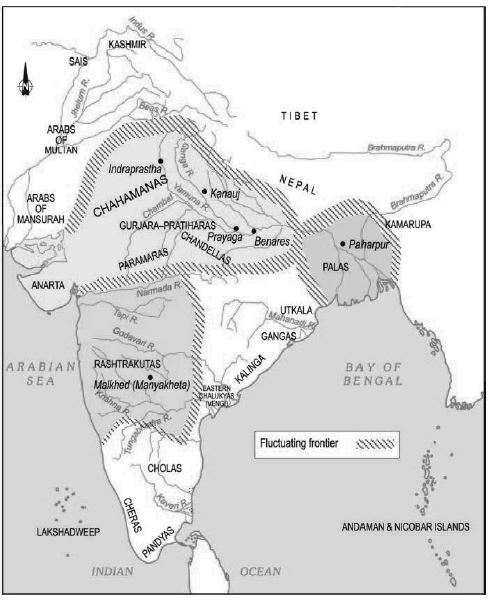Question 1:
Who were the parties involved in the “tripartite struggle”?
Answer:
The tripartite struggle was between three parties to gain control over Kanauj, which was very important from strategic point of view. The parties involved in the tripartite struggle were Gurjara-Pratihara, Rashtrakuta and Pala dynasties.
Question 2:
What were the qualifications necessary to become a member of a committee of the sabha in the Chola Empire?
Answer:
There were certain qualifications for a person to become a member of a committee of the sabha
in the Chola Empire and these are given below:
(i) The person should have land from which land revenue can be collected.
(ii) The person should have his own home.
(iii) The age of that person should be between 35 to 70 years.
(iv) That person should be well-versed in the Vedas.
(v) That person should be honest and well-versed in administrative matters.
Question 3:
What were the two major cities under the control of the Chahamanas?
Answer:
The two major cities under the control of the Chahamanas were the regions around Delhi and Ajmer.
Question 4:
How did the Rashtrakutas become powerful?
Answer:
Rashtrakutas ruled over the Deccan. Actually, they were under the rule of Chalukyas of Karnataka. A Rashtrakuta chief named Dantidurga rose against the Chalukyas ruler and announced his independence. He performed a ritual called hiranya-garbha with the help of the Brahmans, The ritual signified the “rebirth” of the sacrificer as a Kshatriya even if he belonged to another caste.
Question 5:
What did the new dynasties do to gain acceptance?
Answer:
During this age, many new dynasties came into being and made efforts to gain acceptance. For example, the Rashtrakutas performed a ritual called hiranya-garbha with the help of the Brahmans so that they could become Kshatriyas, which was a necessary condition to become kings at that time. In the same way, Kadamba Mayurasharman and the Gurjara-Pratihara Harichandra gave up their traditional professions of being Brahmans and became warriors so that their kingdoms could be accepted by the society.
Question 6:
What kind of irrigation works were developed in the Tamil region?
Answer:
In the Tamil region, many new channels were made from Kaveri river for irrigation of fields. These channels carried fertile soil with which the productivity of agriculture increased on the banks of these channels. In the delta region, small embankments were made to prevent flooding. Even artificial methods were used for irrigation. In some areas, wells were dug and at some places, huge tanks were made for collecting rain water. In this way, a lot was done for developing the irrigation facilities in the Tamil region.
Question 7:
What were the activities associated with Chola temples?
Answer:
In the Chola empire, people started to live around the Chola temples which became the nuclei of settlements. Temples were granted land by the kings and these temples were also the centres of craft production. Income from this land was used for the maintenance of those also who worked for the temples like priests, cooks, musicians, garland-makers, sweepers and dancers. These temples were the places of worship as well as the hub of socio-cultural and economic life.
Question 8:
Do you think being born as a Kshatriya was important in order to become a ruler during this period?
Answer:
No. For instance, the Kadamba ruler, Mayurasharman and the Gurjara-Pratihara ruler, Harichandra were Brahmans who gave up their traditional professions and became warriors. They successfully established kingdoms in Karnataka and Rajasthan respectively.
Question 9:
In what ways was this form of administration different from the present-day system?
Answer:
(i) In the present day system, no forced labour can be demanded from the peasants and others
in the form of taxes.
(ii) Rule of law is imposed.
(iii) No use of force is done.
Question 10:

Answer:
They made these claims to show their superiority and capabilities.
Question 11:

Answer:
(i) The cities of Kanauj and the Ganga valley were a prized area, as they were very fertile.
(ii) Gurjara-Pratihara, Rashtrakuta and Pala dynasties had controlled these areas for
centuries.
Question 12:

Answer:
The Chahamanas attempted to expand their control to the west and the east, where they fought with the Chalukyas of Gujarat and the Gahadavalas of western Uttar Pradesh to become more powerful.
Question 13:

Answer:
No, the women did not participate in these assemblies. In our view, lotteries are not useful
in choosing the members of the committees. The best way of choosing is through
elections.
(b) No, there were no Brahmans in this hamlet. The Brahmans lived separately in temples or
adjoining buildings. The activities which took place in the village were:
(i) Agrarian labour
(ii) Rearing of cocks
(iii) Making of drums
(iv) Husking of paddy These activities did not find place in the inscriptions as they were
considered menial and useless.
Question 14:
The Tang empire was administered by a bureaucracy recruited through an examination, which was open to all who wished to appear for it. In what ways was this system different from those prevalent in the Indian subcontinent?
Answer:
In the Indian subcontinent, the descendant of an emperor became the king after his death, or was overthrown by his son.
